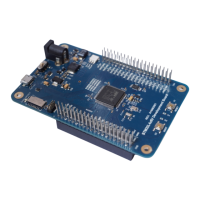DocID024597 Rev 3 1185/1693
RM0351 Universal synchronous asynchronous receiver transmitter (USART)
1282
36.5.2 USART transmitter
The transmitter can send data words of either 7, 8 or 9 bits depending on the M bits status.
The Transmit Enable bit (TE) must be set in order to activate the transmitter function. The
data in the transmit shift register is output on the TX pin and the corresponding clock pulses
are output on the CK pin.
Character transmission
During an USART transmission, data shifts out least significant bit first (default
configuration) on the TX pin. In this mode, the USARTx_TDR register consists of a buffer
(TDR) between the internal bus and the transmit shift register (see Figure 383).
Every character is preceded by a start bit which is a logic level low for one bit period. The
character is terminated by a configurable number of stop bits.
The following stop bits are supported by USART: 0.5, 1, 1.5 and 2 stop bits.
Note: The TE bit must be set before writing the data to be transmitted to the USARTx_TDR.
The TE bit should not be reset during transmission of data. Resetting the TE bit during the
transmission will corrupt the data on the TX pin as the baud rate counters will get frozen.
The current data being transmitted will be lost.
An idle frame will be sent after the TE bit is enabled.
Configurable stop bits
The number of stop bits to be transmitted with every character can be programmed in
Control register 2, bits 13,12.
• 1 stop bit: This is the default value of number of stop bits.
• 2 stop bits: This will be supported by normal USART, single-wire and modem modes.
• 1.5 stop bits: To be used in Smartcard mode.
• 0.5 stop bit: To be used when receiving data in Smartcard mode.
An idle frame transmission will include the stop bits.
A break transmission will be 10 low bits (when M[1:0] = 00) or 11 low bits (when M[1:0] = 01)
or 9 low bits (when M[1:0] = 10) followed by 2 stop bits (see Figure 385). It is not possible to
transmit long breaks (break of length greater than 9/10/11 low bits).

